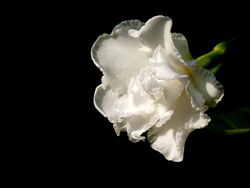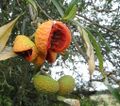Biology:Tabernaemontana
| Tabernaemontana | |
|---|---|

| |
| Tabernaemontana divaricata 'Flore Pleno' | |
| Scientific classification | |
| Kingdom: | Plantae |
| Clade: | Tracheophytes |
| Clade: | Angiosperms |
| Clade: | Eudicots |
| Clade: | Asterids |
| Order: | Gentianales |
| Family: | Apocynaceae |
| Subfamily: | Rauvolfioideae |
| Tribe: | Tabernaemontaneae |
| Subtribe: | Tabernaemontaninae |
| Genus: | Tabernaemontana Plum. ex L. 1753 |
| Synonyms[1] | |
| |
Tabernaemontana is a genus of flowering plants in the family Apocynaceae. It has a pan-tropical distribution, found in Asia, Africa, Australia, North America, South America, and a wide assortment of oceanic islands.[1][2] These plants are evergreen shrubs and small trees growing to 1–15 m tall. The leaves are opposite, 3–25 cm long, with milky sap; hence it is one of the diverse plant genera commonly called "milkwood". The flowers are fragrant, white, 1–5 cm in diameter.
The cultivar T. divaricata cv. 'Plena', with doubled-petaled flowers, is a popular houseplant.
Some members of the genus Tabernaemontana are used as additives to some versions of the psychedelic drink ayahuasca;[3] the genus is known to contain ibogaine (e.g. in bëcchëte, T. undulata), conolidine (present in minor concentration in T. divaricata)[4] and voacangine (T. alba, T. arborea, T. africana).[5] Because of presence of coronaridine and voacangine in Mexican Tabernaemontana species,[5] those plant could be used in economic production of anti-addictive alkaloids especially ibogaine and ibogamine.[6] T. sananho preparations are used in native medicine to treat eye injuries and as an anxiolytic, and T. heterophylla is used to treat dementia in the elderly.[7] Conolidine may be developed as a new class of pain killer.[8] Caterpillars of the oleander hawk-moth (Daphnis nerii) have been found to feed on the pinwheelflower (T. divaricata).
Taxonomy
- Publication
The genus was described by Carl Linnaeus and published in Species Plantarum 1: 210–211 in 1753. The type species is T. citrifolia.
- Etymology
The genus name commemorates the "father of German botany" Jakob Theodor von Bergzabern, a.k.a. Jacobus Theodorus Tabernaemontanus, Tabernaemontanus being a compressed form of the original Medieval Latin name (Tabernae Montanus) of the botanist's home town of Bergzabern - both the Latin and the German forms of the town's name meaning "tavern(s) in the mountains".
- Species[1]
Gallery
Habitus of T. divaricata
T. elegans (toad tree) : undehisced fruit
Tabernaemontana catharinensis: dehiscence of paired, ripe fruits, revealing black seeds in deep orange pulp.
T. pandacaqui (banana bush)
See also
- Psychedelic plants
- Compounds found in Tabernaemontana
References
- ↑ 1.0 1.1 1.2 "WCSP (2013). World Checklist of Selected Plant Families". Facilitated by the Royal Botanic Gardens, Kew. http://apps.kew.org/wcsp/synonomy.do?name_id=200545.
- ↑ Flora of China Vol. 16 Page 152 狗牙花属 gou ya hua shu Tabernaemontana Linnaeus, Sp. Pl. 1: 210. 1753.
- ↑ Ott (1995)
- ↑ Kam, Toh-Seok; Pang, Huey-Shen; Choo, Yeun-Mun; Komiyama, Kanki (2004). "Biologically Active Ibogan and Vallesamine Derivatives from Tabernaemontana divaricata". Chemistry & Biodiversity 1 (4): 646–656. doi:10.1002/cbdv.200490056. PMID 17191876.
- ↑ 5.0 5.1 "Quantification of Anti-Addictive Alkaloids Ibogaine and Voacangine in In Vivo- and In Vitro-Grown Plants of Two Mexican Tabernaemontana Species". Chemistry & Biodiversity 13 (12): 1730–1737. December 2016. doi:10.1002/cbdv.201600146. PMID 27448833.
- ↑ "Metabolite Profiling of Anti-Addictive Alkaloids from Four Mexican Tabernaemontana Species and the Entheogenic African Shrub Tabernanthe iboga (Apocynaceae)". Chemistry & Biodiversity 16 (4): e1800506. April 2019. doi:10.1002/cbdv.201800506. PMID 30618175. Template:Errata
- ↑ Rodrigues & Carlini (2006)
- ↑ "Scientists create new type of painkiller". 23 May 2011. http://www.abc.net.au/science/articles/2011/05/23/3224191.htm.
- Ott, Jonathan (1995): In: Ayahuasca Analogues: Pangaean Entheogens.
- Rodrigues, Eliana & Carlini, E.A. (2006): Plants with possible psychoactive effects used by the Krahô Indians, Brazil. Revista Brasileira de Psiquiatria 28(4): 277–282. PDF fulltext
Wikidata ☰ Q310915 entry
 |







